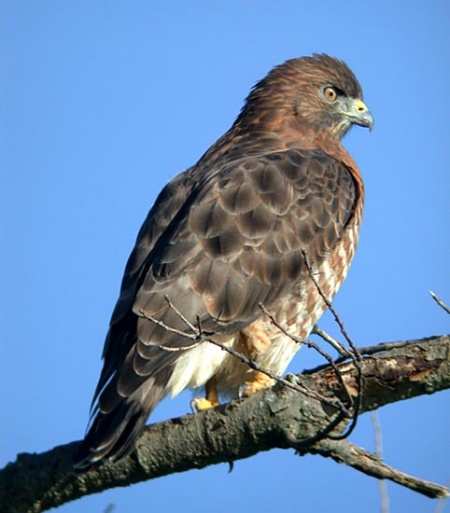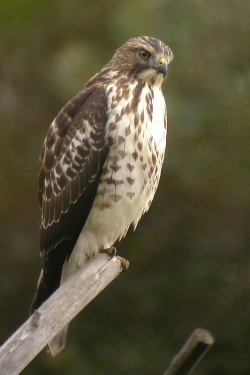- Buteo platypterus
Identification
Length: 34-44 cm (13.5-17.5 in); wingspan: 81-100 cm (31.75-39.25 in); weight: 275-560 g.
The second smallest buteo in North America, the Broad-winged Hawk is a small, stocky hawk with broad black and white tail bands.
There is a rare dark phase morph.
Distribution
Breeds in North America and the Caribbean, winters from southern USA to South America.
In summer, the North American range includes from Southern Canada extending west almost to British Columbia to Florida and Texas.
Migrates in large groups called "kettles" from Northern South America to the Eastern United States. Is often observed in large numbers during migration at "hawk watches" throughout the Eastern U.S and Canada.
Taxonomy
The nominate race (platypterus) is a well known buteo of the USA and southern Canada east of the Rockies. This subspecies is a migrant wintering south to northern half of South America.
Five other non-migratory subspecies occur in the Caribbean: cubanensis, brunnescens, insulicola, rivierei, and antillarum, with populations on Cuba, Puerto Rico, and most islands in the Lesser Antilles reaching south to Grenada. It is increasingly a visitor to Hispaniola.
Habitat
Whilst preferring deciduous forests, is also found in rainforests and second growth, river valleys and coastal sage scrub.
Behaviour
Most often hunts from perches taking various types of prey.
Diet
Their diet includes snakes and crocodile eggs.
The voice is a characteristic whistle.
References
- Clements, JF. 2011. The Clements Checklist of Birds of the World. 6th ed., with updates to August 2011. Ithaca: Cornell Univ. Press. ISBN 978-0801445019. Spreadsheet available at http://www.birds.cornell.edu/clementschecklist/downloadable-clements-checklist
- BF Member observations
Recommended Citation
- BirdForum Opus contributors. (2024) Broad-winged Hawk. In: BirdForum, the forum for wild birds and birding. Retrieved 30 April 2024 from https://www.birdforum.net/opus/Broad-winged_Hawk






